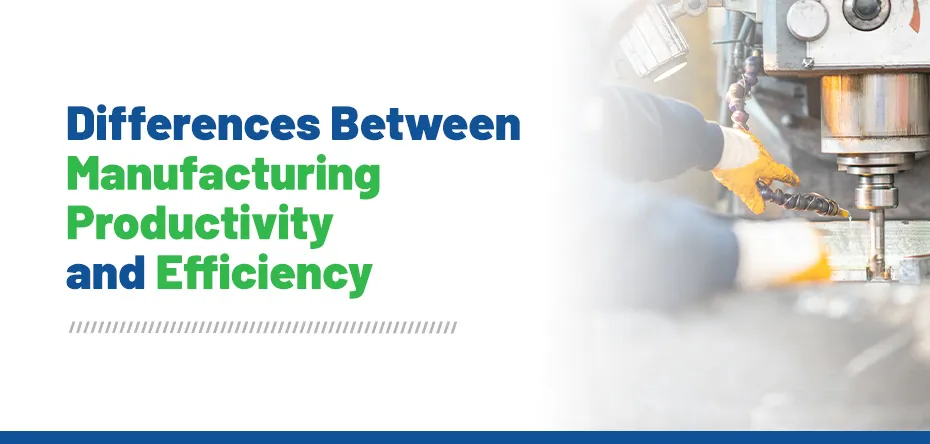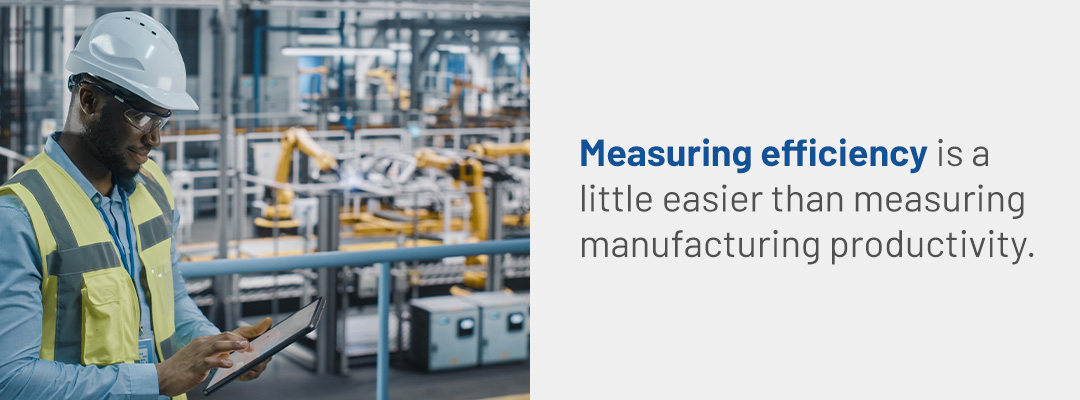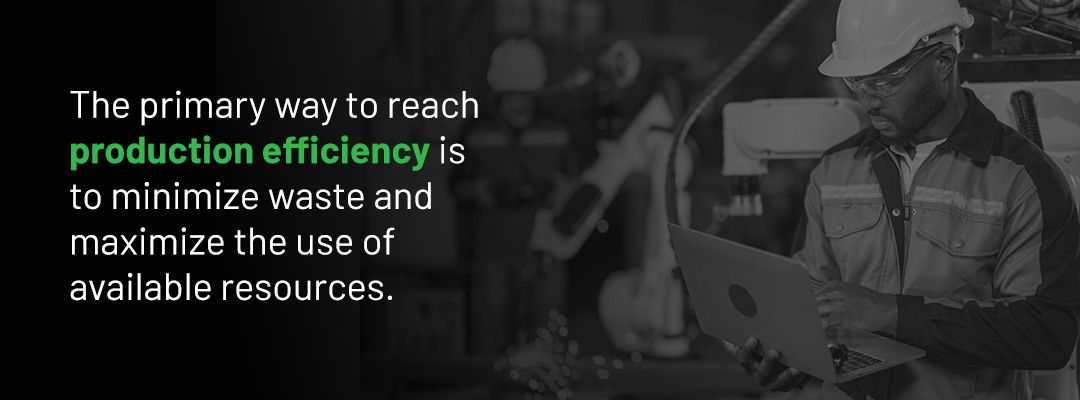Differences Between Manufacturing Productivity and Efficiency
In the manufacturing industry, businesses are always trying to optimize their operations. They aim to drive down production costs while boosting throughput, all while retaining the quality of their products.
Productivity and efficiency are two metrics that help manufacturers measure the effectiveness of everything from their team to their equipment.
Finding the right balance between productivity versus efficiency helps make the most of manufacturing processes. Learn more about the differences between the two and a few helpful ways to improve efficiency.
Manufacturing Productivity and Manufacturing Efficiency Defined
Manufacturing productivity measures refer to the rate of completion for a specific process. It is almost always linked directly to human performance or processes that rely on human interaction. You can calculate productivity by dividing your manufacturing outputs by your inputs. Your inputs are resources, such as:
- Human capital
- Physical capital
- Technological knowledge
- Raw materials
- Energy
- Finances
Your outputs are your final product. This could be a good or service created by any of the following:
- Machines
- Factories
- Companies
- Individuals
You boost manufacturing productivity by either increasing the outputs with the same quantity of inputs or getting the same output with fewer inputs. Productivity is a factor in efficiency, but not vice versa.
Efficiency refers to completing the production of a good or service while wasting as little time, materials, and energy as possible.
This measure is all about making the most of your resources and minimizing waste in all forms. Manufacturing operations aim to maximize efficiency without compromising productivity. Efficiency is a broader look at both the effectiveness and quality of work.
You typically note efficiency as a percentage. The goal is to reach 100% production efficiency to make the most of your manufacturing processes.
How Do You Measure Efficiency in Manufacturing?
Measuring efficiency is a little easier than measuring manufacturing productivity.
There are a few challenges associated with measuring productivity. Companies that manufacture physical goods can have a hard time identifying productivity pertaining to human performance. Pinpointing the effectiveness of an individual’s work is much more challenging than measuring the team’s productivity altogether. Multiple employees may work on one unit, which makes it difficult to determine who is productive and who may be hindering processes.
The measure of productivity demonstrates the performance of a process over time. This is sometimes confused with a manufacturer’s yield. Yield refers to the quantity of non-defective goods divided by the number of items produced overall.
Finding manufacturing efficiency is a bit more straightforward.
Calculating Efficiency
In short, you can calculate efficiency by dividing your actual output rate by the standard output rate and multiplying the result by 100.
Before you can measure efficiency, you’ll need to find your operation’s outputs. Calculate your actual output by dividing your total input by your total output.
Your output refers to your final products. For example, you could create 100 products for $300. Your input is the $300 worth of material and labor costs. The 100 products are your output. Calculate your actual input by dividing the $300 costs by the 100 products. In this example, your actual output is $3 per product.
Then you need to find your standard output, which you can find by looking at:
- Your efficiency history
- Industry standards
- Competitor’s efficiency
Continuing with the same example, you could compare your actual output with a competitor’s. Perhaps they are producing 120 of the same items for the same costs as you. Their actual output would be $2.50 per product.
When you divide your actual output by your competitor’s actual output ($3 per product/$2.50 per product), you’ll find that your competition is 120% more efficient in producing these products.
Alternative Ways to Find a Manufacturer’s Overall Efficiency
There are multiple ways to calculate a manufacturer’s efficiency. In addition to the formula above, you can use overall equipment effectiveness (OEE) and material yield variance.
The basic formula for OEE is:
- OEE = Availability x Performance x Quality
Availability is run time divided by planned production time. Performance indicates the ideal cycle time multiplied by the total quantity of products, which is then divided by run time. You can find quality by dividing the good count by the total quantity. Once you find these values and plug them into the formula, you can find your OEE. Use this figure to analyze efficiency over time.
Material yield variance is slightly different, and its formula is:
- Material yield variance = (actual yield – standard yield) x standard unit cost
Actual yield refers to the quantity of material used. Standard yield is the quantity of materials that you expect to use. Ideally, a manufacturer would not use more materials than anticipated.
Understanding Productive Efficiency
Productive efficiency is also known as production efficiency. It is a measurement that helps manufacturers identify the optimal conditions to produce goods at the lowest cost possible. The primary way to reach production efficiency is to minimize waste and maximize the use of available resources.
Every month, the Federal Reserve shares an industrial production and capacity utilization report that analyzes the productive efficiency of these industries:
- Manufacturing
- Mining
- Electric
- Gas utilities
Balancing Productivity and Efficiency in Manufacturing
Ideally, a manufacturer would be able to maximize both efficiency and productivity without compromising the other. In reality, making the most of efficiency often means dedicating more time to the details of production, therefore decreasing productivity. This is why businesses have to find ways to strike a balance between the productivity of their workers’ performance and the efficiency of their processes.
Before you can find ways to manage both, it can help to understand the factors that affect each measurement. The following impacts your team’s productivity:
- Management
- Workplace layout
- Breaks
- Training
- Technology
- Input materials
- Engagement
- Stress
- Workloads
- Available resources
These factors impact your operation’s efficiency:
- Working hours
- Pay and incentives
- Employee relationships
- Monitoring
- Machine maintenance
- Operational goals
Once you understand the fundamental differences between the two, you can begin finding ways to maximize both. Some actions could help you manage productivity and efficiency simultaneously, including:
- Conduct regular analysis: It can be very valuable to assess your operations and identify any areas you can improve. Whether that is reducing time spent on certain activities or taking steps to enhance product quality, fine-tuning your processes can boost both efficiency and productivity.
- Find ways to be more profitable: You can find better balance when you explore ways to boost profitability. This may mean identifying areas in your process where you can streamline activities or prioritize to improve gains.
- Understand your market: One of the greatest ways to find the right balance for your business is by examining your target market. They will help you prioritize what is most important. For example, if your customers are willing to pay more for higher quality products, focus on efficiency. If your market is looking for the most cost-effective products, you may want to give more focus to productivity.
- Engage with your team: Find ways to balance productivity and efficiency by communicating with your team to find common challenges they are facing. This can be a good starting point for tracking the improvements throughout your manufacturing operation.
Methods to Improve Manufacturing Efficiency
The following are ways you could refine your manufacturing operations to improve efficiency:
1. Eliminate Waste
Your business could save ample funds by taking measures to cut down on all types of waste. One of the greatest ways to boost efficiency is minimizing waste in the form of:
- Materials
- Energy
- Time
- Space
Material waste is especially expensive for manufacturers. Consider how you could change your design to cut back on wasted scraps. Look into ways to convert waste into money through recycling programs or selling. Explore methods to rework your processes to make the most of your tools and materials.
2. Standardize Work
When working with a team, it is inevitable that each person has their own way of approaching tasks. All this variation can cost your business valuable time and manpower.
Standardizing these tasks can keep everybody’s work consistent and maximize efficiency. You could begin by creating checklists for each step in the manufacturing process. This can reduce downtime and resolve questions about best practices. Even simple tasks should have a regulated path to completion.
Task standardization can also save you time in training, as you’ll have developed a streamlined method you can easily communicate to employees.
3. Invest in Modern Line Equipment
Another effective way to boost efficiency is to evaluate your current production line. Investing in modern line equipment can lead to major improvements in efficiency.
At EAM-Mosca Corporation, our conveyors and turners can help your business improve performance and save costs at the production line. Newer equipment means less downtime spent on repairs and maintenance. Introducing new pieces into your factory or workspace can help streamline your operations and free up valuable time for your team.
4. Train Employees on Best Practices
Do not underestimate the power of extensively training your employees. When your team understands the equipment they work with and your operation’s best practices, you can both reduce downtime and improve efficiency.
Your employees will be able to better troubleshoot problems and work together to come up with effective solutions. When every member of the team understands the processes, they can easily substitute for each other and enhance their understanding of how your manufacturing operation works.
We offer comprehensive training programs for your strapping systems. We understand the need for your employees to have proper training, especially for new equipment, and aim to help boost your production efficiency in any way we can.
5. Maintain Equipment to Avoid Breakdowns
Preventative maintenance of machines is essential for maximizing your manufacturing efficiency. Regular care helps keep your machinery in perfect working order, thus reducing downtime caused by malfunctions or repairs. Upkeep allows you to identify potential issues early on before they become expensive problems.
In addition to regular maintenance, it is beneficial to respond to equipment breakdowns promptly before they have a chance to worsen. Our support services range from technical assessments to in-house remote technical troubleshooting to keep your machines at their optimal efficiency.
6. Quantify Everything You Can
An additional way to enhance efficiency in your manufacturing operation is to quantify everything in your process, from materials to working hours.
While the cost of materials is simple to calculate, other aspects of the business are more ambiguous. Assigning a dollar value to each facet of your process will help you illuminate the areas that need more attention and tuning up. When you quantify everything in your production, you can easily find places to boost overall efficiency, as calculating efficiency will also be easier.
7. Stay Organized
The organization of your workspace has a direct influence on operational efficiency.
Consider setting up your space to cater to your employees’ activities. You will want to optimize the area to reduce unnecessary movement and obstacles. Your equipment layout should streamline your manufacturing process, not inhibit it.
Proper organization will help your team easily locate their tools, freeing up more time for their work. Having everything in an assigned location will help your team move around the workplace with greater safety, as well, reducing downtime.
8. Identify Bottlenecks
You can improve manufacturing efficiency by taking the time to identify bottlenecks in your operations. Take inventory of your processes and look for signs of the following:
- Accumulation: If you notice accumulation at a specific production line, this is likely a bottleneck that needs your attention.
- Throughput: Pay close attention to the throughput of your production lines. One of your machines may be causing a bottleneck and this is an easy way to identify it.
- Full capacity: Look at each machine’s fixed capacity. This reflects a percentage of its full capabilities. Machines that are causing a bottleneck often use a higher percentage of their capacity, and you can use this to identify the problem.
- Wait times: Take wait times into consideration when looking for bottlenecks. Typically, the part of the process that is a bottleneck will be the step prior to the machine with long wait times.
Learn More About Strapping Solutions From EAM-Mosca Corporation
EAM-Mosca Corporation is committed to improving manufacturing productivity and line efficiency. With more than three and a half decades of experience installing more than 25,000 machines throughout the U.S., we understand the need for high-quality automatic strapping machines.
Our systems boost productivity and help with package protection so your operation can meet its goals. You can reduce downtime and make the most of your team’s performance. We offer easy no-obligation quotes and customer support programs meant to help our customers make the most of their operations.
To learn more about our strapping and packaging solutions, contact us today.






